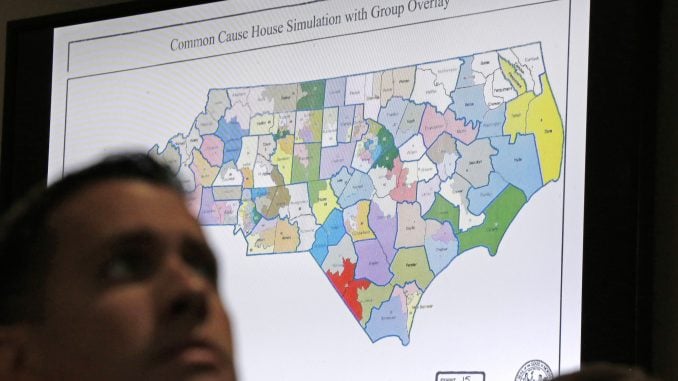
RALEIGH — North Carolina legislators, who are redrawing dozens of General Assembly districts that judges deemed illegal partisan gerrymanders, turned Monday to considering district lines generated by a key expert for those who successfully sued over the maps.
The House and Senate redistricting committees met to figure how they would enact new boundaries for the 2020 election by a court-mandated Sept. 18 deadline. Last week, a three-judge panel declared Republican mapmakers violated the state constitution by manipulating districts created in 2017 to help elect a maximum number of GOP candidates and make it nearly impossible for Democrats to win majorities.
Republicans have held legislative majorities since 2011 and have been sued repeatedly this decade over electoral maps they’ve drawn. They disagree with the unanimous decision from state court. But they are not appealing the ruling, which orders that election results and other partisan data like voter registration be omitted from the process of shaping districts.
It’s “an unprecedented moment in the history of redistricting in North Carolina,” said Sen. Paul Newton (R-Cabarrus), Senate redistricting committee co-chairman. “Never before has this legislature been ordered not to consider partisanship in drawing maps … the rules of the road have now changed.”
The ruling came barely two months after the U.S. Supreme Court decided partisan gerrymandering was not the purview of federal courts, but suggested it could still be acted upon by state courts.
“If the justices in Washington, D.C., won’t protect people’s constitutional rights — won’t ensure that all voters have a fair opportunity to participate in our democracy — then the courts of North Carolina will fix the problem themselves,” said Stanton Jones, a chief lawyer in the lawsuit filed by Common Cause, the state Democratic Party and Democratic voters.
Jones and others spoke at a news conference before the committee meetings in which they urged GOP lawmakers to fully carry out the court’s demands. The court said remapping of 57 House districts and 21 Senate districts must be conducted “in full public view.”
The three judges cited evidence from the files of now-deceased Republican mapmaker Thomas Hofeller to declare he privately drew most of the 2017 House and Senate districts several weeks before lawmakers actually set mapmaking criteria.
Republican redistricting leaders proposed separately in Monday’s committee meetings that replacement districts be based on a set of 1,000 simulated House and Senate maps generated by Jowei Chen, a University of Michigan redistricting expert who testified for the plaintiffs in the July trial. The judges appeared to find persuasive Chen’s findings that the 2017 maps displayed Republican bias, compared to the maps he generated by computer that left out partisan and racial considerations.
Under the GOP proposals, only districts generated by Chen that scored best on principles like compactness and minimizing split voting precincts and municipal boundaries would be considered. Amendments could be considered to ensure pairs of incumbents aren’t placed in the same proposed district, forcing them to compete against one another for reelection.
“If we choose any of Dr. Chen’s modeling runs, we know that our base map will be a compliant map, a fair map in the eyes of the court,” Newton said. Democrats on the committees generally supported using Chen’s maps, given the time crunch, but others raised cautions about it.
However, some Democratic senators on Tuesday voted against a motion by Newton in the Senate redistricting committee to adopt Chen’s maps as a starting point. Their reason was because Chen did not have home address data for some of the legislators elected in 2018. Without that data, some incumbents could be “double bunked” meaning that sitting members could be drawn into the same district.
The Democratic opponents of the motion argued that the committee should select a map that entirely ignores incumbency data and then consider amendments to rectify double-bunking. Senate Republicans argued that the committee should adopt maps that already consider incumbency for most legislators and then address double-bunking through amendments.
The committee voted to select the maps created by Chen with several Democrats voted against it.
Newton said, “Our priority is to adopt maps that maximize compliance with the court’s order. The nonpartisan maps that we proposed adopting as a starting point were drawn by the Democratic Party’s own mapmaker and already used by the court as a model of compliant, nonpartisan districts. That the Democrats would vote against their own expert’s maps defies logic.”
The court’s order, which requires public transparency, is leading to actions directed at improving public access. The state House and Senate redistricting committees on Tuesday started live-streaming their meetings to comply with the courts order that the remapping must be conducted “in full public view.”
The Senate also has brought in a state lottery machine with pingpong balls inside to pick certain maps at random, in keeping with transparency.
The final House and Senate maps would have to be approved by both chambers. Redistricting plans aren’t subject to Democratic Gov. Roy Cooper’s veto.
Exactly how or whether new maps would improve Democratic chances to take back majorities in 2020 aren’t immediately clear. Democrats would need to win six additional House seats or five Senate seats to flip one or both chambers. Whichever parties win majorities in 2020 will control the once-a-decade redistricting the following year.

